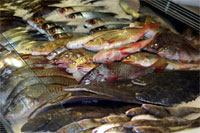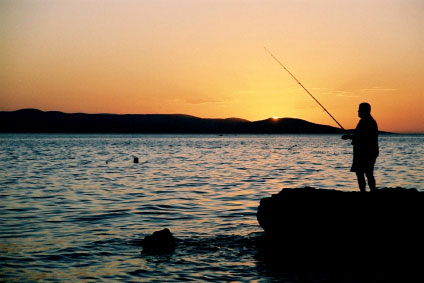|

 A Very Large Family: The flatfish are an order (Pleuronectiformes) of ray-finned fish,
also called the Heterosomata, sometimes classified as a suborder
of Perciformes. The name means "side-swimmers" in Greek.
In many species both eyes lie on one side of the head, one or the
other migrating through and around the head during development.
Some species face their "left" side upward, some face
their "right" side upward, and others face either side
upward. The other distinguishing features of the order are the presence
of protrusible eyes, another adaptation to living on the sea-bed
(benthos), and the extension of the dorsal fin onto the head. A Very Large Family: The flatfish are an order (Pleuronectiformes) of ray-finned fish,
also called the Heterosomata, sometimes classified as a suborder
of Perciformes. The name means "side-swimmers" in Greek.
In many species both eyes lie on one side of the head, one or the
other migrating through and around the head during development.
Some species face their "left" side upward, some face
their "right" side upward, and others face either side
upward. The other distinguishing features of the order are the presence
of protrusible eyes, another adaptation to living on the sea-bed
(benthos), and the extension of the dorsal fin onto the head.

 A Healthy Appetite: In Europe, the name flounder refers to Platichthys flesus, in the
Western Atlantic, there are summer flounder (Paralichthys dentatus),
winter flounder (Pseudopleuronectes americanus), in Japan there
are Japanese flounder (Paralichthys olivaceous). Flounders lie on
their sides on the ocean floor; in adulthood, both eyes are situated
on the right or left (dependent upon species), upward-facing side
of its body. Flounder sizes typically vary from five to fifteen
inches, though they sometimes grow as long as three feet in length.
Their breadth is about one-half of their length. The flounder feeding
ground is the soft mud of the sea bottom, near bridge spiles, docks,
and other bottom incumbrances; they are sometimes found on bass
grounds as well. Their diet consists mainly of fish spawn, crustaceans,
polychaetes and other fish. A Healthy Appetite: In Europe, the name flounder refers to Platichthys flesus, in the
Western Atlantic, there are summer flounder (Paralichthys dentatus),
winter flounder (Pseudopleuronectes americanus), in Japan there
are Japanese flounder (Paralichthys olivaceous). Flounders lie on
their sides on the ocean floor; in adulthood, both eyes are situated
on the right or left (dependent upon species), upward-facing side
of its body. Flounder sizes typically vary from five to fifteen
inches, though they sometimes grow as long as three feet in length.
Their breadth is about one-half of their length. The flounder feeding
ground is the soft mud of the sea bottom, near bridge spiles, docks,
and other bottom incumbrances; they are sometimes found on bass
grounds as well. Their diet consists mainly of fish spawn, crustaceans,
polychaetes and other fish.
Gone Fish': Flounder fishing is best in spring and autumn. Flounder may be
caught in summer, but the meat will be soft and unpleasant for eating.
Flounder will bite at almost anything used for fish bait, including
any kind of tackle. Use a small hook; No. 8 being the recommended
size. Flounder are an excellent pan fish, but they should be cooked
as soon as possible after being caught.

All text is available under the terms
of the GNU Free Documentation License
|